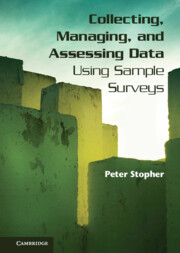Book contents
- Frontmatter
- Contents
- Figures
- Tables
- Acknowledgements
- 1 Introduction
- 2 Basic statistics and probability
- 3 Basic issues in surveys
- 4 Ethics of surveys of human populations
- 5 Designing a survey
- 6 Methods for conducting surveys of human populations
- 7 Focus groups
- 8 Design of survey instruments
- 9 Design of questions and question wording
- 10 Special issues for qualitative and preference surveys
- 11 Design of data collection procedures
- 12 Pilot surveys and pretests
- 13 Sample design and sampling
- 14 Repetitive surveys
- 15 Survey economics
- 16 Survey implementation
- 17 Web-based surveys
- 18 Coding and data entry
- 19 Data expansion and weighting
- 20 Nonresponse
- 21 Measuring data quality
- 22 Future directions in survey procedures
- 23 Documenting and archiving
- References
- Index
6 - Methods for conducting surveys of human populations
Published online by Cambridge University Press: 05 June 2012
- Frontmatter
- Contents
- Figures
- Tables
- Acknowledgements
- 1 Introduction
- 2 Basic statistics and probability
- 3 Basic issues in surveys
- 4 Ethics of surveys of human populations
- 5 Designing a survey
- 6 Methods for conducting surveys of human populations
- 7 Focus groups
- 8 Design of survey instruments
- 9 Design of questions and question wording
- 10 Special issues for qualitative and preference surveys
- 11 Design of data collection procedures
- 12 Pilot surveys and pretests
- 13 Sample design and sampling
- 14 Repetitive surveys
- 15 Survey economics
- 16 Survey implementation
- 17 Web-based surveys
- 18 Coding and data entry
- 19 Data expansion and weighting
- 20 Nonresponse
- 21 Measuring data quality
- 22 Future directions in survey procedures
- 23 Documenting and archiving
- References
- Index
Summary
Overview
There are a number of different ways in which a human population can be surveyed. The method that probably preceded any others was that of face-to-face interviewing. In this method there is a trained interviewer, who intercepts the respondent by some means and then conducts the survey by asking questions and writing down the answers. A second, and quite different, method is to write out the questions in a questionnaire of some type, and send this questionnaire to prospective respondents in the post. The respondent then reads through the questionnaire and writes down his or her responses to the questions, and sends back the completed form to the survey agency.
A third survey method, which it has been possible to use extensively only since about the 1970s, is a telephone survey. In its pure form, a telephone survey differs from the face-to-face survey only in that the interviewer and respondent are no longer face to face but, instead, are speaking to one another over the telephone. The survey is conducted by the interviewer again asking questions of the respondent, and noting down the answers. A fourth type of survey is one that has become feasible only since the late 1990s. In it, the respondent is presented with questions on the internet, and then responds to the questions by either typing in answers or clicking on a ‘radio button’ to indicate the answer that the respondent prefers. These four methods represent the four basic methods that are available for interactive surveys with human populations – i.e., surveys in which the respondent provides answers to questions posed by the survey organisation.
- Type
- Chapter
- Information
- Collecting, Managing, and Assessing Data Using Sample Surveys , pp. 104 - 126Publisher: Cambridge University PressPrint publication year: 2012



